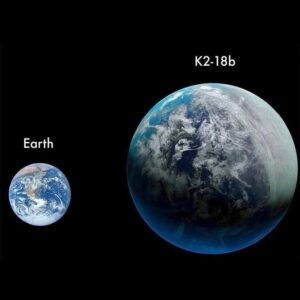In 2025, scientists detected the presence of either dimethyl sulphide (DMS) or dimethyl disulphide (DMDS) in the atmosphere of K2-18b.

What is K2-18b?
- K2-18b is an exoplanet, meaning it is a planet located outside of our solar system. It is situated 124 light-years away from Earth in the constellation Leo and orbits a star named K2-18.
- Discovered in 2015 by the Kepler Space Telescope, K2-18b is about 5.2 times the width of Earth and approximately 9 times more massive, suggesting it may have a hydrogen-rich atmosphere.
- The planet receives a similar amount of stellar radiation from its star as Earth does from the Sun, which raises the possibility of conditions that could support life on its surface.
Atmospheric Discoveries
- In 2019, the Hubble Space Telescope detected water vapor in K2-18b’s atmosphere.
- Subsequently, the James Webb Space Telescope (JWST) identified the presence of carbon dioxide (CO₂) and methane (CH₄).
- Notably, the lack of ammonia combined with the detection of CO₂ and CH₄ in a hydrogen-dominated atmosphere could indicate the potential existence of liquid water oceans on the planet.
About Dimethyl Sulphide (DMS)
- Dimethyl sulphide (DMS) is considered a potential biomarker, as it is primarily produced by phytoplankton in Earth’s oceans.
- DMS is generated when phytoplankton die, and enzymes break down dimethylsulphoniopropionate. It is also released in small quantities during volcanic eruptions and when soil bacteria decompose plant matter.
- A study from 2015 found that 76% of soil bacteria on Earth possess a gene responsible for producing DMS, reinforcing its biological origin.




